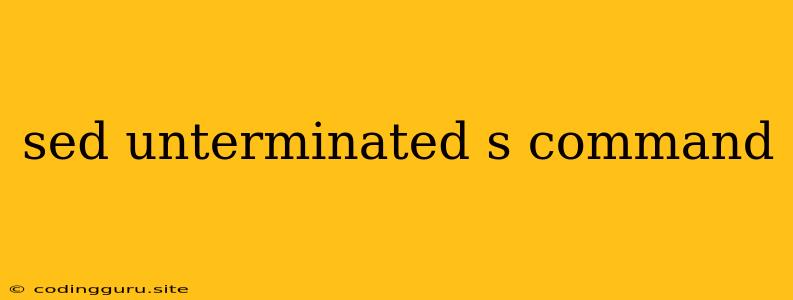The "sed: unterminated s command" Error: A Guide to Understanding and Solving It
Have you ever encountered the frustrating "sed: unterminated s command" error while working with the powerful sed command in Linux? This error indicates a problem with the syntax of your sed command, specifically with the s (substitute) command. It essentially means you've forgotten to close the s command properly, leaving sed in a state of confusion.
Let's dive into understanding this error and how to resolve it efficiently.
What is the "sed: unterminated s command" Error?
The sed command is a powerful stream editor in Linux. It's used to manipulate text files, performing actions like substitutions, deletions, insertions, and more. The s command within sed is the core for performing text substitutions.
The error "sed: unterminated s command" occurs when the s command is not properly terminated. This can happen for a few reasons:
-
Missing delimiter: The
scommand requires a delimiter to define the text to be replaced. For example:sed 's/old/new/g' file.txtHere,
/acts as the delimiter. If you forget this delimiter or use an incorrect one, you'll face the error. -
Unescaped delimiter: If the delimiter itself is present within the text to be replaced, you need to escape it. This can be achieved by placing a backslash
\before the delimiter. For instance:sed 's/\/old\/new/\//g' file.txtThis escapes the
/delimiters within the text. -
Missing final delimiter: The
scommand needs a final delimiter after the replacement text. This is crucial for closing the command properly. If you miss this, you'll encounter the error.
How to Fix the "sed: unterminated s command" Error
Here's a step-by-step guide to troubleshoot and fix this error:
-
Check the Syntax: Carefully review your sed command. Ensure that the
scommand has the following structure:s/pattern/replacement/flags- pattern: This is the text you want to replace.
- replacement: This is the text that will replace the pattern.
- flags: These are optional modifiers like
g(global) which apply the substitution to all occurrences of the pattern.
-
Identify the Delimiter: The delimiter separates the pattern, replacement, and flags. It can be any character except a space or newline. Common delimiters include:
/(forward slash)#(hash)@(at symbol)
Make sure you have used a delimiter and haven't missed it accidentally.
-
Escape Delimiters: If your pattern or replacement text contains the same delimiter, escape it using a backslash
\. For example:sed 's/\/old\/new/\//g' file.txtHere, the forward slashes within the pattern are escaped to avoid confusing them with the delimiters.
-
Verify Closing Delimiter: Ensure you have a closing delimiter after the replacement text. If it's missing, sed will interpret the command as unfinished.
-
Use Single Quotes: Enclose the entire sed command within single quotes
' '. This helps avoid unintended shell expansion and ensures that special characters within the command are treated literally.
Examples
Here are some examples of how to fix common errors:
-
Error:
sed 's/old/new' file.txt- Problem: Missing closing delimiter.
- Solution:
sed 's/old/new/g' file.txt
-
Error:
sed 's/old/new/g file.txt- Problem: Missing delimiter before
g. - Solution:
sed 's/old/new/g' file.txt
- Problem: Missing delimiter before
-
Error:
sed 's/old/new//g' file.txt- Problem: Unescaped delimiter within the pattern.
- Solution:
sed 's/\/old\/new/\//g' file.txt
Tips for Avoiding the "sed: unterminated s command" Error
-
Use Delimiters Consistently: Choose a delimiter and stick to it throughout your sed command. This helps in maintaining readability and reduces the chances of errors.
-
Escape Special Characters: Always escape delimiters, special characters like
*,?,.,+, and|, within your pattern or replacement text. -
Test Carefully: Before running your sed command on an important file, always test it on a copy to ensure it produces the desired results.
Conclusion
The "sed: unterminated s command" error is a common syntax issue encountered while using the s command within sed. By understanding the fundamentals of the s command and carefully checking your syntax, you can effectively resolve this error. Remember to escape delimiters, use quotes properly, and always test your sed commands before running them on important files.
